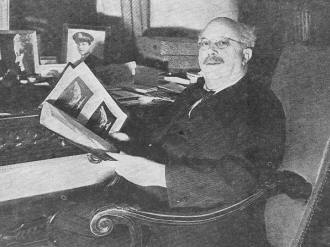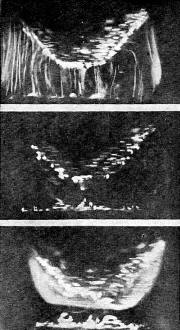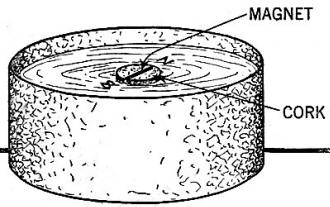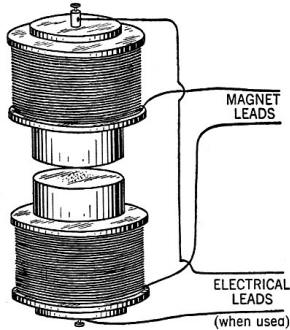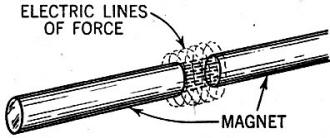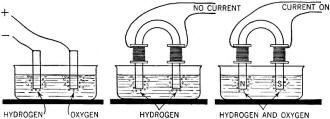Magnetic Current - Discovery of the Age?
|
|
It was a big deal in 1944 when Austrian physicist Dr. Felix Ehrenhaft announced that he had discovered "magnetic charges," aka magnetic monopoles. He claimed based on numerous kinds of experiments that a reversible "magnetic current" existed around current-carrying conductors. It seems based on my reading of this Radio-Craft article that he believed there existed mono-magnetic particles of some sort analogous to electrons and protons. Later experiments seems to indicate that high intensity light beams could also produce evidence of magnetic currents. Dr. Ehrenhaft widely promoted his conclusions and invited doubters to examine his apparatus. Based on some Web searches on the topic, independent researchers were not able to reproduce his findings, so his work eventually faded into the background. Some credit his experiments with light for demonstrating the particle nature of light's ability to accelerate masses. The most profound implication of proving the existence of magnetic monopoles would be nullification of Maxwell's equation stating that the surface integral for a magnetic field about an enclosed area has to equal zero, precluding the existence of magnetic monopoles (aka Gauss' law for magnetism). Some theories in astrophysics, in order explain observed phenomena, depend upon monopoles, so maybe the arguement is not yet settled. The Big News - Pure Magnetic Current Magnetic Current - Discovery of the Age? By Fred Shunaman Electrical science may well be on the verge of a new era; an age in which magnetism will duplicate or exceed the advances of current electricity. The action of magnetic particles in a strong field, movement of electrically-charged bubbles of gas spirally around a magnetic field set up in a liquid, and above all, the decomposition of water by magnetism, prove that some new thing has been discovered. How important such discoveries are, and what their effects may be, only the future can tell. The greatest advance in science since Oersted discovered that electricity and magnetism are interrelated, may well have been heralded by Dr. Felix Ehrenhaft, when he announced at a recent meeting of the American Physical Society that he had proved experimentally the existence of magnetic current. Electrically-charged gas bubbles in a liquid between the poles of a magnet, move in a way similar to magnetic "lines of force." World-Wide Photos Magnetism has always been the mysterious twin sister of electricity. It is known that all electric current is invariably accompanied by a magnetic field, and that electricity can be produced with the help of magnetism - as in the ordinary dynamo. Yet practically nothing is known of the nature of magnetism itself. Our present concepts on magnetism, as Dr. Ehrenhaft pointed out to the Society, are based on experiments which probably originated with the ancient Chinese, and were formulated for the modern world by the philosopher Peregrinus in 1269. Peregrinus found that a magnet floating on water directs itself in a North-South direction, but does not move, once it has assumed its North-South position. From this arose the theory that magnetism has direction, but no motion. Ehrenhaft, like Peregrinus, makes his experiments with magnets, but uses sub-microscopic particles of iron, nickel, antimony, manganese or chromium, which, in the form of powder, are inserted between the plates of a "magnetic condenser." (See Fig. 2.) This condenser is a gap between the ends of two iron rods 8 millimeters in diameter. The gap is 2 millimeters wide. Spools of wire are placed around the rods, permitting them to be strongly magnetized in either direction. Thus the field in the magnetic gap can be changed at will. The poles can also be connected to a source of D.C., and a voltage applied in the manner of an ordinary electric condenser. Electrostatic or magnetic fields, or both together, can thereby be set up across the gap. When a minute amount of the finely powdered metals mentioned above are placed in the exact center of the lower electrode and the magnetic field applied, some of these particles move toward the upper plate, while others remain at rest. If the small metal dust particles are suspended in the air between the two faces of the condenser, application of a magnetic field will cause some of them to move toward the North face, others toward the South face. The obvious conclusion is that these particles must be magnetically charged, some with North and some with South magnetism. To persons who have been brought up in the orthodox theory, this is hard to believe, We have been taught that if an ordinary bar magnet is broken, each of the broken pieces will be a perfect magnet, with its own North and South pole. (Fig. 3.) This is known as Maxwell's experiment, and from it he concluded that if the magnet were still further broken, a whole series of smaller and smaller magnets would be formed, and that each of these would have its North and South pole, even if the whole magnet consisted of only one molecule of iron. Fig. 1 - This experiment convinced Peregrinus that magnetism had no tendency to flow, and fixed our ideas on the subject for 800 years. Fig. 2 - The Ehrenhaft condenser. Magnetic or electric fields may exist between its faces. Fig. 3 - Maxwell's experiment. If an ordinary magnet is broken in two each half is a magnet. This caused the belief that unipolar magnets cannot exist. Fig. 4 - Small electrically charged particles revolve around a magnetic field as do "lines of force" around a wire carrying electricity. Fig. 5 - Left: Ordinary electrolysis of water. Center: Bubbles of hydrogen rising from both ends of the iron rod. Right: When magnetized, both oxygen and hydrogen me from the poles. Dr. Ehrenhaft believes that his experimental work proves that such is not the case - that small particles may have unit polarity - may be magnetically charged either North or South. If, in the condenser experiment, each of the microscopic bits of magnetic dust had been a true magnet, complete with North and South poles, they should have aligned themselves with the magnetic field, but certainly should not have moved away from the pole on which they were resting. It is hard to explain that by any other theory than that of the unipolar magnetic particle, a pure North pole or one with South polarity only. Effects in Liquids Another striking example of the magnetic current is the movement, under the influence of a magnetic field, of small particles of such metal as nickel in liquids. The Ehrenhaft condenser, submerged in liquid, has the same effect on these small particles that it has in air. Furthermore, on reaching one or the other of the poles, the magnetic particles are deposited in a manner similar to that of electroplating. To avoid possible electric effects, the poles of the magnet were electrically short-circuited during this experiment. The result might be called "magnetoplating," rather than electroplating. If small particles are subjected to a strong electric charge while moving in the magnetic field, their course becomes a spiral. They circulate around the magnetic field, much as magnetic "lines of force" are supposed to revolve around a conductor carrying electric current. See Fig. 4. Says Ehrenhaft, "In the same way the constant electric current is surrounded by magnetic force lines closed in circles, the constant magnetic current is surrounded by electric force lines closed in circles." "Magnetolysis" of Water A further experiment produces effects not previously discovered in the whole his-tory of magnetism. The ends of a horse-shoe shaped electromagnet of plain, Swedish iron were inserted into acidulated water. Chemical action released bubbles of hydrogen. The iron was then magnetized, and instead of pure hydrogen, the gasses released contained from 2 to 12% of oxygen. Fig. 5. The water is actually decomposed by the magnet, as it can be decomposed' by an electric current. While oxygen is released from both ends of the magnet, the larger amount comes from the North pole. The same experiment, repeated with a permanent magnet, resulted in a weakening of the magnet by about 15% over a 24-hour period. This is very significant. If decomposing water reduces the strength of a magnet, it is only reasonable to suppose that the magnetic must be the cause of such decomposition. A further point adduced in favor of the new theory of magnetism is that it is possible to magnetize sub-microscopic particles with light or friction. Every experimenter knows how simple it is to produce a unipolar electric charge on such a body as a piece of glass, paper or hard rubber. Particles placed between the plates of the Ehrenhaft condenser, if irradiated with light, begin to move toward one pole or the other. Is the Problem Cracked? If the experiments just described have been correctly observed and interpreted, magnetism is shown to have many of the attributes formerly supposed to belong- exclusively to electricity. Small particles may be "charged" to a single polarity, North or South. They may be thus charged by some outside influence such as light. Unit poles placed in a magnetic field tend to move toward the pole of opposite magnetic polarity, and electrostatic charges revolve in closed circles around the "magnetic current," as do magnetic "lines of force" (charges?) around an electric current. Our preservation of an almost complete ignorance of magnetism through all the startling advances in current electricity and electronics is one of the great marvels of modern science. It would not be surprising if some one should at last crack this problem. Dr. Ehrenhaft believes that he has done so, and has proposed experimental proof that "Electricity and magnetism are an indivisible pair. The unification of the field theory has been indicated in an experimental way, and electricity and magnetism may have to be expressed in the future by one symbol only."
Posted December 14, 2020 |
|

